Dr. Hoi F. Cheu: Compassionate Biblionaut
Exploring the meaning of life at the intersection of science and literature
Dear Reader,
It is widely believed that the road to a good life passes through a few good books. Abiding by this adage and in continuation of our research into the subject matter of bibliotherapy, in this installment of Corners of the Mind, we delve into the extraordinary mind of Dr. Hoi F. Cheu, Professor at Laurentian University in Ontario, Canada, as we attempt to explore how the stories we tell ourselves and others help us comprehend, and even save our own lives.
Hailing from the Far East, Dr. Cheu, is an accomplished interdisciplinary academician, deeply respected by his colleagues and beloved by his students. In his answers below, which reverberate with wisdom and compassion, he shares with us his accumulated knowledge from a life steeped in literature and servitude to humanity through academia and bibliotherapy, all the while providing us with serious intellectual stimulation and nutritious book recommendations. Reader, prepare to be inspired.
Dear Dr. Cheu, it is a pleasure and an honor to have you on Corners of the Mind to answer a few questions about your life, academic work, and bibliotherapy. To start with, please share with us the biggest milestones of your life’s journey from your early academic beginnings in Hong Kong to your current position as a Full Professor at the Laurentian University of Canada and, most recently, Director of Laurentian’s Doran Planetarium.
I think you said it in the question – I was a science student in HK, and I studied English all the way to complete a doctoral degree. Then I returned to science as a communicator. Bibliotherapy and health research are my interdisciplinary venture of integrating science and literature in research.
In recent decades, the exchange or move of students and persons of intellect from one part of the globe to another has led to some very interesting academic discoveries that would otherwise have been difficult, or even impossible, without this intertwining of civilizations. Your Ph.D. thesis, “Zen and the Art of James Joyce,” blends an oriental philosophy of being with a much-celebrated writer of the West. Please enlighten us regarding your intellectual navigation of the two worlds and your groundbreaking conclusion which could not have been reached had you not used an intercultural approach.
Zen Buddhism attracted me as an intellectual approach to engage compassion; it was the same that attracted me to Literature. In Zen and the Art of James Joyce, I was trying to sort out how to engage post-structural theories – the dominant critical frameworks of the time – to explore Zen Buddhist writings and the works of James Joyce. The central issue was the practices of language as a way of disillusionment – particularly it was the disillusionment of indoctrination through language that brought the two together. I never approached that as an attempt to blend oriental philosophy with Western writing. It was to me a study of a human behaviour called writing. Joyce struggled all his life as a self-exiled rebel against the indoctrination of Catholicism and the paralysis of Irish politics; Zen Buddhism, similarly, self-deconstructed (in Jacques Derrida’s sense of deconstruction) the language of Buddhism. I think Zen Buddhism is true Christianity without the “Word” (Λόγος) of God, and James Joyce is a true Zen Buddhist without the words of the Buddha.
We are made of stardust; we are this universe coming into consciousness – as Carl Sagan argues in Cosmos.
- Dr. Hoi F. Cheu
You are an avid reader and we can only imagine the number of books you have spent hours with throughout your career and life. Having said so, do you have a preferred literary genre or writer you often return to for comfort or guidance?
Currently, I spend most of my reading time on astronomy and the sciences of compassion (about half and half). The former has to do with my work with the planetarium at the university, and the latter has to do with my work on bibliotherapy. In my mind, however, they are interconnected. We are made of stardust; we are this universe coming into consciousness – as Carl Sagan argues in Cosmos.
Literary writing that means much to me are stories of compassion and stories about human struggles to foster meaningful relationships with one another, with animals, with the environment and the Universe. I still return to reading James Joyce constantly, but many of my new favorites for teaching include Ted Chiang’s Stories of Your Life and Others, Jeanette Winterson’s The Stone Gods, Julian Barnes’ The Noise of Time, and The Sense of an Ending. I would consider Carl Sagan’s Cosmos a great work of literary writing – it is a work of brilliant storytelling; it is just non-fictional.
Your academic research focuses, among others, on the art and healing outcomes of bibliotherapy, in addition to you being a practicing bibliotherapist. Please tell us what initially sparked your interest in engaging with this subject, both in theory and practice.
My academic research focus – if there is one – is the Story Species (a term coined by my mentor Joseph Gold after the book by Terrance Deacon called The Symbolic Species). The theory is that the human brain is co-evolved with language (Deacon) and therefore humans form their consciousness through narratives to comprehend identities and relationships with each other and the universe. Many therapeutic techniques deal directly with people’s personal narratives – talking about their past, challenging them to re-narrate or rewrite their life stories in various ways. Bibliotherapy uses Literature – well-written stories created by other people – to engage the process indirectly. The advantages of bibliotherapy include that (1) we are in the safer space of other people’s stories, and (2) the insights and thoughts are communicated not from the “clinic” but in print.
The first is important esp. when dealing with traumas because traumatic experience fragments our self-narrative, making it dysfunctional and thus requiring therapy. As the brain tries to suppress memories of trauma, people develop symptoms like stress disorder, multiple personality complex, etc. Dealing with traumatic experiences directly triggers those problems more easily than working with other people’s stories elsewhere. The second has to do with “transference” – in a clinical setting, that means the patient’s negative emotions being transmitted to the therapist. E.g. being angry at a parent or a spouse can be redirected to become anger towards the therapist. When we are dealing with a work of literature, however, the emotion may instead be transferred to a fictional character, and in such a way, maintaining a healthier relationship within the clinical setting. If the insights and/or the thoughts come from some authors, we can discuss them from a safer distance – instead of having the therapist tell the patient in which the hierarchal power differential may cause conflicts.
The use of other art forms has similar effects but different advantages and disadvantages. Music is even more indirect because it is more abstract; fine art is great for emotional expressions, esp. for those who have less developed language skills, such as children; film is more visual and less hard work than reading, but the film medium is harder for communicating thoughts. Reading is great because it involves more of the brain – but for that, it is also harder to engage. Good clinicians use them according to needs and circumstances – effective techniques are non-exclusive.
Literature remains a powerful tool because the human brain makes stories to connect the dots of otherwise a chaotic and incomprehensive world of experiences and relations.
- Dr. Hoi F. Cheu


Do you use a specific method or approach as a bibliotherapist?
I engage in bibliotherapy through Compassion Focused Therapy (CFT) – a term coined by Paul Gilbert in the early 2000s. In the 1990s, I learned from my mentor Joseph Gold (author of The Story Species and Read for Your Life) who advocated Literature as a tool of consciousness and emphasized the power of Literature for nurturing human empathy. He introduced me to Systems Therapy – which was founded on the principle that people were not isolated individuals but part of a complex system. Empathy and self-awareness in this complex system help us develop well-being. Compassion Focused Therapy is another step, in my view, advancing from empathy to compassion. In either focus, Literature remains a powerful tool because the human brain makes stories to connect the dots of otherwise a chaotic and incomprehensive world of experiences and relations.
If there is a common issue, the issue is that the story is not working. We can get help from literature to make it work again.
- Dr. Hoi F. Cheu
As a practicing bibliotherapist with years of experience, which do you identify as the most common “issue” people reach out to you about?
I do not practice much clinically because my main job has been research and teaching for the past 23 years. But one important point I can make is that there is no common issue. I am happy that you put quotation marks on “issue.” One common problem in mental health is labelling. The charm of bibliotherapy is that it is about stories. We talk about everyone’s struggle as each of one’s own unique and complex story. What we try to do is to make the story work. So if there is a common issue, the issue is that the story is not working. We can get help from literature to make it work again.
Taking into consideration the various cultural and linguistic backgrounds of your “patients,” do you sometimes refrain from recommending certain books because they might not resonate with their cultural background, or are you of the opinion that the stories are universal and can apply to anyone? In other words, do you find yourself “prescribing” different books as per your “patient's” country or culture of origin?
While books can never be universal, they are not culture-bound. Sometimes stories from other cultures can be more inspiring and fascinating because they offer perspectives that are different. Parallax (different positions make an object appear differently against its background) is an important concept for astronomers to judge distances of stars up to about 600 light-years; it is also why we have two eyes – to have 3-D vision for judging distance. In clinical practices, I do not usually prescribe books. I usually begin with asking people to create their own reading lists. That is a good way for me to listen and learn about the person. Then, if intervention is needed and trust is built, I may sometimes suggest a reading to add to the conversation. Nationality and ethnicity are usually not relevant to the consideration.
In a manner of speaking, our own stories are not even that important to ourselves. If we lock into our own stories, they can in fact cause suffering.
- Dr. Hoi F. Cheu
Dr. Cheu, you are a Zen Buddhism practitioner. How do you think this has affected the way you approach life and your fellow humans as well as your professional path? To the uninitiated reader, which book(s) would you recommend in order to get a glimpse of your spiritual values and codes?
Zen Buddhists coin the term “mind-nature.” We have a mind, and the nature of our mind is that it is a phenomenon. It is not physically real and it is ever-changing. The factors of its existence, in contemporary terms, include hydrogen, nitrogen, carbon, oxygen, genes, neurons, neuro-connections, etc. They make our memories and desires possible. The mind is there, but it is not really there. It is, as The Diamond Sutra describes, “like morning dews, like lightning.” It is, as Joseph Gold would say, “a story.” No one is important to the universe. Life goes on without each of our individual stories, and each individual’s own story is only important to that individual.
Or are they? In a manner of speaking, our own stories are not even that important to ourselves. If we lock into our own stories, they can in fact cause suffering. We can go round and round in a loop of traumatic memories or caught in greed, anger, and obsessive love (the three poisons according to the Buddha). Nevertheless, we can always revise and reframe our stories to make them work better for our well-being. So in another manner of speaking, our stories can help others to revise and reframe theirs as well, and therefore, our stories can be meaningful to us and to others.
Here is a Buddhist description of compassion: we first see that as sentient beings we suffer in a similar way (sympathy); we then find ways to overcome (action compassion); we act by helping others to relieve their suffering because we have been there (concerned compassion); and finally, we cognitively nurture compassion in our mind (aspirational compassion).1
A good entry point to Zen Buddhism – if you want to be “original” – is the Sutra of Hui-Neng.2
On a last note, Dr. Cheu, if you were to recommend the quintessential book for the whole of someone’s life, which one would that be?
The quintessential book has to be a meta-fiction that reveals how stories work for the whole of someone’s life. So I would say Michael Ende’s The Neverending Story.
Thank you so much, Dr. Hoi, for sharing with us your massive knowledge through years of reading, meditating, and caring for people around you and humanity as a whole. Your words are a treasure for anyone interested in exploring life, its meaning, and how to live better with oneself and others.
Last, on a more personal note, when I asked Dr. Cheu to recommend a book/text for a person who finds themselves caught in a midlife conundrum, he responded with the following Zen Buddhism parable:
“A man traveling across a field encountered a tiger. He fled, the tiger after him. Coming to a precipice, he caught hold of the root of a wild vine and swung himself down over the edge. The tiger sniffed at him from above. Trembling, the man looked down to where, far below, another tiger was waiting to eat him. Only the vine sustained him. Two mice, one white and one black, little by little started to gnaw away at the vine. The man saw a luscious strawberry near him. Grasping the vine with one hand, he plucked the strawberry with the other. How sweet it tasted!”3
As always, thank you for being here.
Katerina
Paul Gilbert, “The Evolution and Social Dynamics of Compassion,” Social and Personality Psychology Compass 9(6), 2015, 239-254.
This ancient story was presented as a parable of the Buddha in an unspecified sutra in Zen Flesh Zen Bone compiled by Paul Reps and Nyogen Senzaki, Tuttle Publishing, 1957, reprinted 1998, pp. 38-39.







